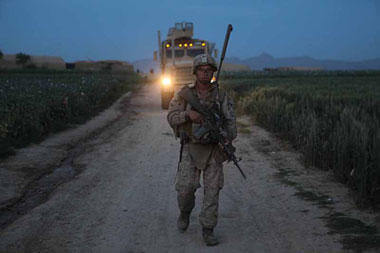Afghanistan's Helmand province, by far the scene of the heaviest coalition casualties of the war, could be abandoned by U.S. and allied forces by year's end, Marine Maj. Gen. Walter L. Miller said Thursday.
The total pullout from Helmand could come with or without agreement on a new Bilateral Security Agreement (BSA) with the Afghan government that would allow for a post-2014 U.S. and NATO presence, Miller said.
"Whether there'll be a presence in Helmand or not – that's still questionable," said Miller, who until last month was commander of Regional Command-Southwest including Helmand and Nimroz provinces bordering Pakistan.
"The decision on whether there'll be Marines there or not – that's still not been made," Miller said.
British Brig. Gen. Paul A. E. Nanson, who was Miller's deputy in Helmand, said the Afghan National Security Forces (ANSF) could no longer count on a coalition presence in Helmand. One might not be included even with a new BSA, Nanson said at a Pentagon briefing with Miller.
Helmand is the world's largest source of poppy made into heroin, according to the U.S. Drug Enforcement Administration, and the mostly desert province has been fiercely contested by the Taliban for the funding they get from the drug trade.
U.S., British and United Nations efforts to promote substitute crops for poppy have largely been ineffective and the poppy harvest has surged, according to recent reports by UN drug trade monitors.
Since the war began in October 2001, more than 940 U.S. and coalition troops have been killed in Helmand, according to the website icasualties.org. The next highest casualty rate was in neighboring Kandahar province to the east, where more than 540 have died.
Up until 2010, British forces had the main responsibility for Helmand and were engaged in heavy fighting in the Korengal valley and the northern Sangin district.
Since 2010, Marine commanders have been in charge in Regional Command-Southwest. In January, 4,000 troops from I Marine Expeditionary Force (Forward) out of Camp Pendleton, Calif., under the command of Brig. Gen. Daniel Yoo began moving to Helmand in what was called the last deployment of Marines to Afghanistan.
In a February visit to Helmand, Gen. James Amos, the Marine Commandant, told troops that when they leave at the end of 2014 "we'll have done every single thing we've set out to do as a Marine Corps," Stars and Stripes reported.
"We're not cutting and running -- Marines don't cut and run. We complete the mission," Amos said at Camp Leatherneck, the main Marine base in Helmand.
At the Pentagon briefing, Miller said that the Marines once had 45 forward operating bases in Helmand and "now we're at nine." Marines also no longer go on patrol with the Afghans and largely focus on helping the ANSF improve their command and control, and logistics efforts, Miller said.
"Right now, they own the battlespace," Nanson said. "There are no more partnered operations."
Miller was confident that the ANSF could hold their own against the Taliban but he acknowledged that the coming fight "remains a significant challenge. It could go either way."
"One-on-one the ANSF will win every fight they're in," Miller said. "The key is going to be the ability to sustain themselves."
The first test will come in providing security for the elections scheduled for April, Miller said.
"They're very confident they're going to be able to pull off the elections," Miller said of the Afghan forces.
Nanson was more cautious. He said he expected the Taliban to "do some sort of disruption" during the elections that would involve "targeting of key political figures." Nanson also noted that it was "poppy harvest time in April" when Afghan troops often go home for weeks to help harvest the crop.
However, Nanson said the ANSF had shown their mettle in recent fighting in the Sangin district. The Taliban had taken over several checkpoints but the ANSF, without support from the coalition, took them back, Nanson said.
"In the early stages of a number of the operations up there, the Taliban were able to amass significant strength to overmatch the checkpoints and take checkpoints," Nanson said. "That was unfortunate. However, the positive was that the ANSF reacted quickly and particularly well, and every time retook the checkpoints within a matter of three or four hours."
"They did it off their own bats," Nanson said, using a cricket term.
Miller predicted that the ANSF was "going to come out on top" against the Taliban. The Marines have now "accomplished their mission. We gave them the tools. We taught them how to use them. It's up to them."
At a Senate hearing on Wednesday, Gen. Martin Dempsey, chairman of the Joint Chiefs of Staff, said the U.S. and NATO partners had essentially agreed on a plan that would leave 8,000-12,000 coalition troops in Afghanistan after 2014.
Afghan President Hamid Karzai has thus far balked at signing a new Bilateral Security Agreement to permit the coalition presence.
Dempsey told the Senate Armed Services Committee that "the options roughly are between 10,000 and zero" post-2014. If the Afghans agree, the coalition presence after 2014 would be centered on hubs in Kabul and the Bagram Air Field, with a "modest presence" in the four corners of the country, Dempsey said.
"We'll be prepared to support a variety of options over the next several months as our relationship with Afghanistan moves forward," Dempsey said. "This includes, of course, the option to draw down by the end of the year if that's the decision made by our elected leaders."
-- Bryant Jordan can be reach at bryant.jordan@monster.com




























